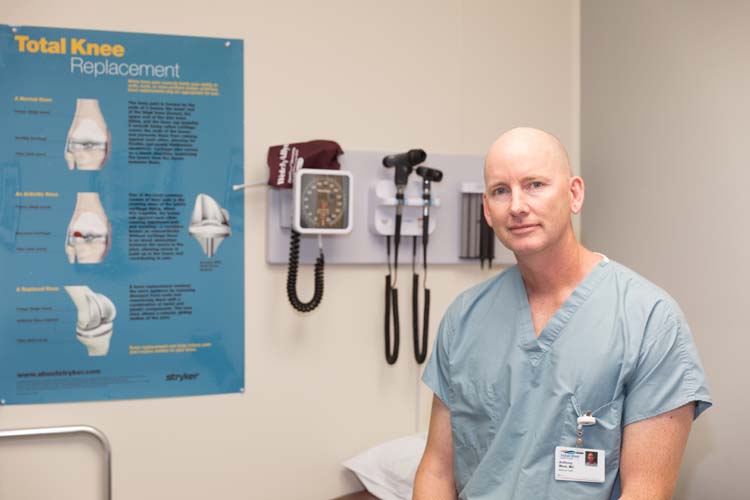
It’s not hard to get Sebastian River Medical Center and Steward Health orthopedic surgeon Dr. Anthony Ware to talk about knee replacement surgery.
Keeping up with him? Well, that’s another matter altogether.
Let’s start with this: The first knee replacements were performed in this country back in 1968, and over the ensuing half-century, according to the Agency for Healthcare Research and Quality, knee replacement operations are now “one of the most successful procedures in all of medicine.”
That’s a good thing since, as Fox News reports, “every 45 seconds, a patient in the U.S. undergoes a knee replacement surgery.”
The positive results have come, in part, due to a steady evolution in procedures, materials and technical innovations over the past 50 years, and Ware can give you chapter and verse on the advances.
One of the most recent innovations, according to Ware, is the use of 3D printing to create a replacement knee joint that precisely matches the dimensions, curves and contours of the patient’s – unlike a pre-made “stock part.”
Specifically, he points to the ConforMIS iTotal CR knee replacements, the third generation of this particular technology.
Ware was the first orthopedic surgeon in Indian River County to employ this “custom-built” approach for replacement knee joints and his motivation was a simple one.
Even though knee replacements have a high overall success rate, the outcomes using standard parts are far from perfect. Up to 40 percent of knee-replacement patients complain about residual knee pain long after their operations and Ware thinks he knows why.
Since the 1960s, most manufacturers of replacement joints have made a limited number of sizes.
“Most knee systems will have only about eight different sizes,” Ware says.
That has in most cases forced orthopedic surgeons to saw off part of the patients’ natural femur and/or tibia in order to make the off-the-shelf parts fit properly.
That’s a problem Ware’s patients don’t have to deal with if they elect to have their replacement joints custom-made – 3D printed replacements fit like a Savile Row suit, or better.
It works like this: Patients get a CT scan of their entire limb. Using that data, the manufacturer – in this case ConforMIS – creates a two-dimensional design that is fed into a 3D printer. The printer then, layer-by-layer, creates an incredibly accurate mold for the replacement joint.
Are these 3D joints really better?
Both Orthopedic Design & Technology and the peer-reviewed Journal Arthroplasty Today think so. They say “a smaller percentage of knee replacement patients treated with [custom-3D-printed] implants experienced any adverse events at discharge or 90 days after discharge when compared to off-the-shelf replacement joints.”
Want more? Becker’s Spine Review says patients with custom-made joints are 1.7 times more likely to have “excellent” results than patients with “off-the-shelf” knee replacements. Likewise, patients with stock parts were 2.6 times more likely to achieve a “poor” rating than those with personalized joints. And Ware says the price is about the same for both procedures.
That said, there are a couple of things to consider. The first is time.
Patients who select the ConforMIS option, Ware says, have to wait “about six weeks” for the implant to be made. Second, patients with a “large deformity of the knee” are not good candidates for a custom-made joint.
Currently, Ware says he is “probably doing 40 percent” custom joints and 60 percent off-the-shelf ones, in part because many people with severe knee pain want something done now, not six weeks from now.
Asked what’s on the horizon for joint replacements, Ware says, “I’m not sure if it’s public knowledge yet, but ConforMIS is … working on a custom-performance total hip” joint.
Dr. Anthony Ware is with the Steward Medical Group and the Sebastian River Medical Center. He has offices in Vero Beach and in Sebastian. The phone number is 772-778-0600.



